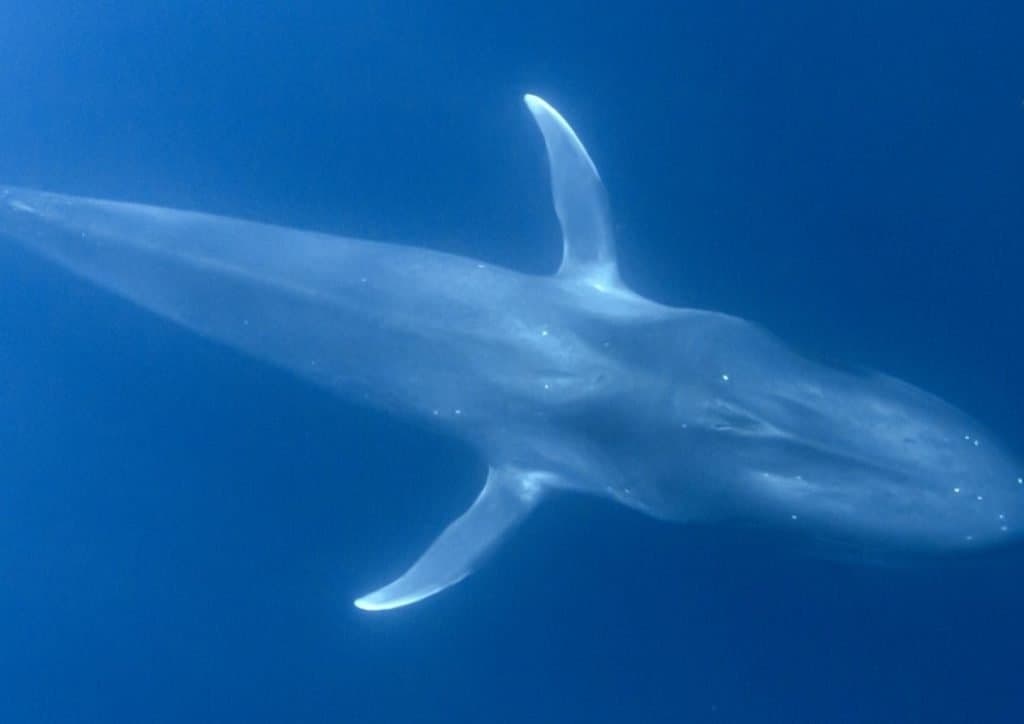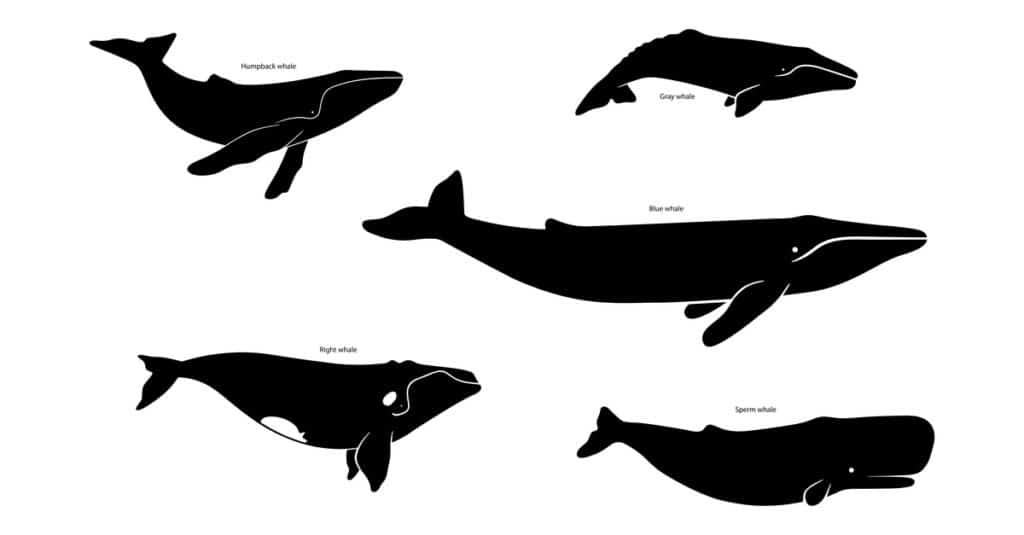Blue whales are some of the most magnificent creatures on the earth. Their massive size is hard to comprehend with whales growing to be up to a 100 feet long. That is the length of three school buses parked end to end! Blue whales are the largest animal in the world and have few if any predators…except humans. Which begs the question: are blue whales endangered?
Are Blue Whales Endangered Today?

A blue whale underwater
©Rich Carey/Shutterstock.com
Yes, as of 2021 the blue whale is classified as endangered by the IUCN. They’re also protected by various acts and laws such as the Endangered Species Act in the United States (more on laws protecting whales below).
The impacts humans have had on whales in general and on blue whales specifically have been dramatic over the years. Commercial whaling began in the 11th century and continued until we as a society agreed that the devastation to the whale populations needed to stop. In the early 20th century governments realized they would need to do something to manage the whaling industry and ultimately to protect the whales. After WWII, the countries responsible for the majority of whaling formed the ICRW (International Convention for the Regulation of Whaling) which in turn created the IWC (International Whaling Commission). They created rules but these were hard to enforce and whaling continued for years until 1986 when an international ban on whaling was put into effect, this was extremely effective. Whaling halted around the world and continues to be illegal. However there are three countries that ignore the ban and continue commercial whaling; Japan, Norway and Iceland.
According to Greenpeace, “The blue whales of the Antarctic are at less than 1 percent of their original population.” Blue whales – despite their size – have historically been hard to count and are spread across an incredible area. Recently scientists have begun using advanced technologies like artificial intelligence to get a better count of blue whale populations. While its believed that blue whales in the Southern hemisphere are seeing an ‘astonishing’ rebound in recent years, their worldwide population isn’t widely believed to number more than 25,000 as of 2021. As of 2018, the IUCN estimated that Antarctic populations of blue whales still numbered only 3,064 mature adults.
Clearly commercial whaling has had a devastating effect on whale populations and the blue whale population. The ban on commercial whaling has made a significant difference in their survival and saved thousands of whale lives. There still remains many threats to these species and they are still listed as endangered by the Endangered Species Act and the IUCN. Let’s take a look at why blue whales are endangered, what continues to be the greatest threats and what are we doing about it.
Why were blue whales hunted in the past?

A blue whale near the surface
©Andrew Sutton/Shutterstock.com
Commercial whaling is what caused the decline and near extinction of the blue whale. The main reason whales were so in demand was their whale oil. In the 18th and 19th century the oil from the whales was used as fuel for the lights and lanterns in so many homes and businesses. It was also used as a lubricant during the industrial revolution. The mouth bristles (baleen) from baleen whales like the bowhead whale were used in women’s corsets and the special oil from sperm whales was used to make candles and used as a lubricant. Blue whales, being the largest whale, had the most mass and the most blubber and oil and therefore were a prized commodity.
Why are blue whales endangered: The top 5 threats to blue whales today

Blue whale underwater, close to the sea surface, chasing a school of fish with an open mouth.
©bekirevren/Shutterstock.com
1. Ship Strikes
The more shipping routes increase into blue whale territory the more blue whales are being struck by vessels causing death. According to the IUCN (International Union for Conservation of Nature and Natural Resources), there is a calve birthing area of blue whales that is just off the coast of Sri Lanka. Over the years this area has become increasingly busy for shipping and in turn has caused an increase in blue whales being hit by ships causing deaths and injuries. As ships get larger and faster there is an increased threat to blue whales. One suggested solution to reduce ship strikes in this area was to move the shipping lanes further away from the shoreline giving these whales more room.
2. Entanglement in Fishing Nets
The World Wildlife Fund is working with the IWC to help the blue whales in the Southern Chile’s Gulf of Corcovado. This area has many salmon farms and industrial fisheries which creates some issues for the blue whales who use this specific area as a feeding ground. Besides an increase in ship strikes in this area too, there are whales that end up being entangled in the fishing nets. The nets can cut off circulation, prevent them from surfacing for air and hinder their ability to get food leading to starvation. The World Wildlife Fund is tagging whales in this area to see which routes they use the most in an attempt to limit the overlap of the fishing industries.
In another part of the world, a recent report by the BBC says, “As many as 60% of blue whales in Canada’s Gulf of St Lawrence have come into contact with fishing ropes and nets, based on scarring seen on photographs snapped by drones.”
3. Climate Change
Blue whales are pretty adaptive when it comes to living in cold waters or warm waters. So why would climate change affect them? The issue is with their food source. Blue whales eat almost exclusively on krill, with some eating up to 6 tons of krill a day! Krill populations are being reduced due to climate change and an increase in the acidity of the ocean. The acidity in the ocean affects the krill’s ability to build its shell. This is not just an issue for blue whales but many species from to penguins to seals depend on these food sources. Scientists are studying phytoplankton, the food source of krill, to find ways to ensure the consistent availability of these tiny players in the ecosystem.

A comparison of some of the largest whales in the world
©Kbel/Shutterstock.com
4. Habitat Loss
Blue whales are located in the waters near Alaska, New/England, Pacific Islands, Southeast and the West Coast. If areas where the blue whale feed, breed, and mate are altered there is a threat that they will be unable to adapt to the changes of the new habitat. Energy production sites that are offshore effect the whale populations as well as recreational use of more and more waters that are habitats for whales. MPA’s or Marine Protected Area programs are helping to set aside areas to protect blue whales and many species from habitat loss.
5. Noise pollution
Whales have a sensitive system of hearing and communication. We are familiar with the humpback whales songs that are elaborate and can be recorded underwater. Blue whales also use a system of songs and sounds for communication and as part of mating. Their moans and groans are some of the loudest and can travel through the water for up to 1,000 miles away. If whales are communicating with each other to begin a migration or to avoid a predator and the message is interrupted by passing ships or naval sonar then you can begin to see why this becomes dangerous. There have also been incidents where whales have been found stranded which may have been caused by the whales surfacing too quickly due to ocean noise pollution and similar to a scuba diver, experience decompression sickness. Conservationists are studying ways to reduce noise pollution and respect the sound environment of marine animals.
The photo featured at the top of this post is © Andrew Sutton/Shutterstock.com
Thank you for reading! Have some feedback for us? Contact the AZ Animals editorial team.







